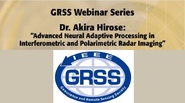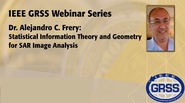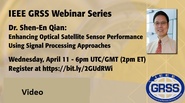
This collection of recorded live webinars is presented by the IEEE Geoscience and Remote Sensing Society (GRSS). Society members enjoy free access to these videos. To learn more about GRSS membership, please visit http://www.grss-ieee.org/about/membership/
Other resources from GRSS, such as slides and tutorials, are available at their resource center.
Showing 1 - 5 of 5
- IEEE MemberUS $11.00
- Society MemberUS $0.00
- IEEE Student MemberUS $11.00
- Non-IEEE MemberUS $15.00
Advanced Neural Adaptive Processing in Interferometric and Polarimetric Radar Imaging - Akira Hirose
This talk presents and discusses advanced neural networks by focusing on complex-valued neural networks (CVNNs) and their applications in the remote sensing and imaging fields. CVNNs are suitable for adaptive processing of complex-amplitude information. Since active remote sensing deals with coherent electromagnetic wave, we can expect CVNNs to work more effectively than conventional neural networks or other adaptive methods in real-number space. Quaternion (or Hypercomplex-valued) neural networks are also discussed in relation to polarization information processing. The beginning half of the Talk is devoted to presentation of the basic idea, overall framework, and fundamental treatment in the CVNNs. We discuss the processing dynamics of Hebbian rule, back-propagation learning, and self-organizing map in the complex domain. The latter half shows some examples of CVNN processing in the geoscience and remote sensing society (GRSS) fields. Namely, we present distortion reduction in phase unwrapping to generate digital elevation model (DEM) from the data obtained by interferometric synthetic aperture radar (InSAR). In polarization SAR (PolSAR), we apply quaternion networks for adaptive classification. Another example is ground penetrating radar (GPR) to visualize underground objects to distinguish specific targets in high-clutter situation. Finally we discuss the prospect of the CVNNs in the GRSS fields.
- IEEE MemberUS $11.00
- Society MemberUS $0.00
- IEEE Student MemberUS $11.00
- Non-IEEE MemberUS $15.00
Statistical Information Theory and Geometry of SAR Image Analysis
Statistics has a prominent role in SAR - Synthetic Aperture Radar image processing and analysis. More often than not, these data cannot be described by the usual additive Gaussian noise model. Rather than that, a multiplicative signal-dependent model adequately models the observations. After summarizing the main distributions for both the univariate (intensity and amplitude) and multivariate (fully polarimetric) image formats, we present eight seemingly different problems, and how they can be formulated and solved in an unified manner from a statistical viewpoint using Information Theory and Information Geometry. A presentation by Dr. Alejandro C. Frery, from the IEEE Geoscience & Remote Sensing Society (GRSS) lecture series, originally broadcast live on IEEE.tv.
- IEEE MemberUS $11.00
- Society MemberUS $0.00
- IEEE Student MemberUS $11.00
- Non-IEEE MemberUS $15.00
Enhancing Optical Satellite Sensor Performance Using Signal Processing Approaches - Video
In order to reduce the risk, shorten the development period and lower the cost of space missions, scientists and engineers at the Canadian Space Agency (CSA) have pioneered signal post-processing technology to enhance satellite sensor performance. Building satellites with considerably high performance is a challenge, as this could be prohibitively expensive or constrained by available technologies. Dr. Qian and his team at CSA have invented a series of cutting-edge technologies to enhance satellite sensors? performance by improving key satellite parameters, such as signal-to-noise ratio (SNR) and spatial resolution using innovative signal processing technologies. Four patents have been granted in USA and Europe and near 20 papers on this subject have been published. They have demonstrated that it is feasible and cost-effective to enhance satellite sensor performance using signal processing approaches. In this lecture, Dr. Qian will briefly introduce a number of innovative signal processing based technologies developed at CSA for improving satellite sensors? SNR and for increasing spatial resolution by exploiting the sensor?s intrinsic characteristics. He will also show the experimental results of the technologies in the evaluation and validation process, and demonstrate how the satellite data acquired by low performance satellites can better serve the remote sensing applications and military target detection after the enhancement using the technologies.
- IEEE MemberUS $11.00
- Society MemberUS $0.00
- IEEE Student MemberUS $11.00
- Non-IEEE MemberUS $15.00
Practical Usage of Remote Sensing Big Data
Remote sensing data is available for agriculture monitoring for very long time. Some of the data resources are regularly updated and they are provided for free commercial and non-commercial usage. We know the added value of the earth observation to land management applications, such as saving costs in agriculture and making right decisions to treat to environment in a friendly way. Nevertheless, most of the agriculture farmers, still cannot benefit from these free resources fully. Travelling to farms around Europe and having Skype calls with farmers all around the world, I curiously tried to find answers to this question; "there is a huge data source available, why can't you use it for improving your agriculture business?" The answers from all around the world were almost the same; 1- The remote sensing data is difficult to access from their existing devices. Either the farmers do not know which online platforms and which software to use, or they do not have good internet access and the required hardware. 2- The remote sensing data is difficult to visualize. Again, the reason is either not knowing which software to use, or not being able to handle big data in a regular pc. 3- Even after the visualization is done, the remote sensing data is difficult to interpret and understand what different colors of a false colored image represent. With my passion on making remote sensing data useful for everyone, last three years, I have worked on building a framework for providing easily accessible and understandable results based on remote sensing, big data processing and augmented reality technologies. In this webinar, I'd like to introduce how the big data challenges are overcome by this application and further potentials of the proposed platform for conscious land management. The lecture will include the following topics followed by a question period: Open data policies, Impact in agriculture, Big data opportunities and problems, How to benefit from big data, What is location-based AR and how to make use of it, Added value, The future of farming, and The future of big data.
- IEEE MemberUS $11.00
- Society MemberUS $0.00
- IEEE Student MemberUS $11.00
- Non-IEEE MemberUS $15.00
Principles Of Synthetic Aperture Radar: Marwan Younis
This lecture is the first module of the course ?Synthethic Aperture Radar Remote Sensing ? Instrument Design, Operation Techniques and Processing? designed by the ?Instrumentation and Future Technologies? (IFT) Technical Committee (TC) of GRSS to foster the understanding of the steps up to the final SAR product, and to convey the knowledge required to actually design a SAR system. ?Principles of Synthetic Aperture Radar? will address the following topics: Functionality of a radar, the resolution of radar, the principle of a synthetic aperture, what does a radar measure, data acquisition, principles of range and azimuth compression, image distortions (foreshortening, layover, etc.).
 Cart
Cart Create Account
Create Account Sign In
Sign In




